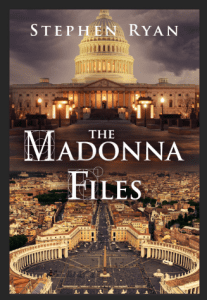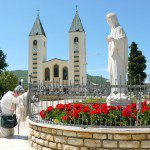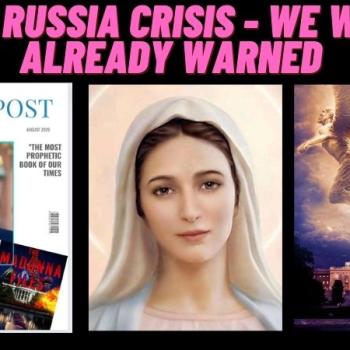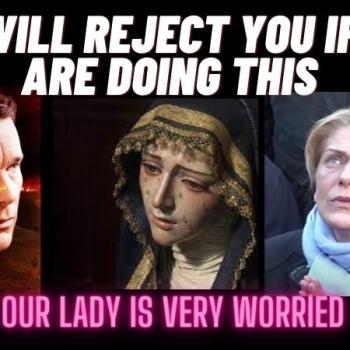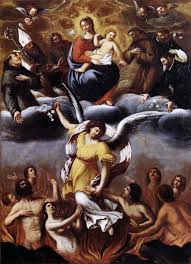
What happens to us after we die? Is there a soul? Is there life hereafter, or is this materialistic reality the end? Throughout life, no matter what religious (or nonreligious) background one comes from, we all ask ourselves these big questions. We all ponder on the answers, especially when we lose loved ones. Is there an afterlife? Is there a soul that continues to live on after the body stops? Or is there nothing else afterward? Is this the end?
Deep questions about death and the afterlife, eternal questions, have also occupied much cultural fascination in recent years. Academy-Award winning director Clint Eastwood has just released a new film on the afterlife called “Hereafter,” starring Matt Damon as a psychic who may provide some answers. Leading atheist intellectual Christopher Hitchens has been afflicted with esophageal cancer and questions about death, the afterlife, judgment, the possibility of a late conversion, have preoccupied commentators observing his ordeal. Hitchens’ younger brother, British intellectual Peter Hitchens, has just authored a book called “The Rage Against God: How Atheism Led Me to Faith,” a spiritual memoir which, among other things, tackles the theme of death. J.K. Rowling has finished her Harry Potter novels by explaining that death constituted the major theme throughout the work, confirming her own belief in an afterlife, as she once stated: “…I do believe in life after death. It’s something that I wrestle with a lot. It preoccupies me a lot, and I think that’s very obvious within the books.”
So, how can we get some concrete answers to these eternal question of what happens after death? Is it even possible to get concrete answers, beyond the mere speculations of filmmakers or writers and novelists (no matter how noble those speculations)? There, in fact, is a way to find out about the life beyond through empirical evidence.
We need to sit-back, observe the findings of a professor who studies Near-Death Experiences and of a couple of mystics who have reported experiencing visions of the afterlife. Do these two sources agree with what lies beyond?
Let us begin with the mystics.
Last month, Cardinal Christoph von Schonborn, the popular Archbishop of Vienna, hosted two of the Medjugorje visionaries in St. Stephen’s Cathedral in Austria. The two visionaries, Ivan Dragicevic and Marija Pavlovic-Lunetti, have reported experiencing daily apparitions of the Virgin Mary since 1981. The visionaries have claimed that, in addition to their apparitional experiences, they have also been shown visions of the afterlife by the Virgin.
Giving her testimony before a packed cathedral on September 23, 2010, the visionary Marija explained what the Virgin Mary has told (and shown) them about the afterlife.
“She said that there are so many people who do not believe that there is Heaven, Hell, and Purgatory. And through the message that she gave us she said that our lives must be like a flower, and that we are here just in a passing way. Only eternal life does not pass. For that reason she urges us, and she asks us, to think more of the spiritual life and of paradise. She wants us to think of Hell and of Purgatory. She said our life will be very different, our attitude toward life will be very different, when we think of the life after this one. And she said we shall really, truly understand that this life is only passing like a flower, and that here we are in this world in a passing path. This is why she urges us: enjoy it….that we may live this short life in joy; that we may understand, as it says in the Bible…that we are truly on a path, that we’re only passing by. This is why Our Lady showed Heaven, Hell, and Purgatory. To show us that these realities exist.”
There is a Heaven, a Hell, and a middle-realm called Purgatory. Can we believe them? Is there any trace of evidence beyond the mere act of faith in what the visionaries tell us? There, in fact, is.
Professor Craig R. Lundahl, who has written many works on Near-Death Experiences, once authored an article in The Journal of Near-Death Studies called “A Comparison of Other World Perceptions by Near-Death Experiencers and by the Marian Visionaries of Medjugorje.”
As the title suggests, the point of the article was to compare the visions of the afterlife that the Medjugorje seers reported with the visions of the afterlife that thousands of people who have undergone Near-Death-Experiences (NDE) have reported. The Near-Death Experience constitutes an otherworldly encounter, wherein a person who has lost all brain activity, leaves their body and believes to have experienced another dimension, a spiritual realm beyond this one. Prof. Lundahl’s findings, between the Medjugorje visions and the Near-Death visions of the afterlife, were quite astonishing, seeing a clear connection between the two. They were not reporting on different realities.
Beginning with the Medjugorje visionaries, what did they see? The three realms of the afterlife that they were shown have been described thus:
Heaven, according to the Medjugorje visionaries, is a huge place of great lights, beauty, and immense joy. Meadows, mountains, hills, beautiful countrysides are all present; people possess an inner light, a serene joy radiates from their presence. Purgatory is a very sad and chilling place. One visionary described it as a misty area with gray fog through which people could be heard trembling, weeping, moaning, and where an extreme loneliness permeates the sadness of the atmosphere. Hell is even more disturbing. The visionaries have described it as a vast place with many people and a great sea of fire in the center. According to the visionaries, the people in Hell are enraged, cursing, ugly, occupied with unending anger. They enter the torturous fires naked and come out horrific, no longer in human shape, in vastly darkened, blackened skin.
Continuing to Prof. Lundahl and his research, what did it show? Are there similarities?
According to Prof. Lundahl, individuals who undergo Near-Death Experiences “describe life after death as consisting of two major divisions with a possibility of a third division.” The first division that Prof. Lundahl analyzed is the “Cities of Lights”—which is immensely similar to what the Medjugorje visionaries describe as Heaven. Numerous people who’ve had near-death encounters have described seeing these Cities of Light. Prof. Lundahl explains how patients have described this realm:
“This division contains countrysides with beautiful landscapes of mountains, hills, valleys, fields of golden grass and flowers, meadows, paths, trails, lanes, roads, great forests, brooks, streams, rivers, ponds, and lakes. The plant life includes grass, flowers, trees of all kinds, shrubs, and vegetable and flower gardens. There is a variety of animal life and insects such as butterflies and bees. Buildings such as houses and some larger buildings are also found in the countrysides.”
Not only were the Medjugorje descriptions similar, and at times identical, in speaking of beautiful countrysides, mountains, hills and meadows, but there is also similarity in the radiating light that the seers reported experiencing in Heaven. Here’s what Prof. Lundahl describes of this radiating light, as experienced in patients who’ve undergone near-death encounters:
“The cities in the first division emanate light. For example, four NDErs described it this way:
‘(My guide) next led me to a city. It was a city of light. It was similar to cities on earth in that there were buildings and paths, but the buildings and paths appeared to be built of materials which we consider precious on earth. They looked like marble, and gold, and silver, and other bright materials, only they were different. The buildings and streets seemed to have a sheen and to glow. The entire scene was one of indescribable beauty…There was a feeling of love and peace. After soaring for a while, she (the angel) sat me down on a street in a fabulous city of buildings made of glittering gold and silver and beautiful trees. A beautiful light was everywhere—glowing but not bright enough to make me squint my eyes.
….and then I saw, infinitely far off, far too distant to be visible with any kind of sight I knew of…a city. A glowing, seemingly endless city, bright enough to be seen over all the unimaginable distance between. This brightness seemed to shine from the very walls and streets of this place, and from the beings which I could now discern moving about within it. In fact, the city and everything in it seemed to be made of light…The beauty of the countryside was incredible but even it could not compare with the splendor of the city because of the glow.’”
The second realm that Prof. Lundahl describes is called, in Near-Death Studies, the Realm of Bewildered Spirits. Prof. Lundahl describes “this division as a dark, gloomy, and hostile environment where millions of unhappy and wicked people who are gray, bewildered, confused, miserable, anguished, dreary, angry, and do not seem to communicate much are confined until they can solve whatever problem they have that appears to be keeping them there.”
Again, in this realm we see many similarities to what the Medjugorje visionaries have described as Purgatory: a dark, gloomy, and gray environment occupied by misery, by unhappy and confused souls. Prof. Lundahl also wonders whether what Near-Death researchers deem as the “Realm of Bewildered Spirits” could constitute another division, one that is Hell. For he acknowledges that many who enter the Realm of Bewildered Spirits describe it as a hellish experience—some more brutal than others. He quotes a patient who encountered this realm:
“The next thing I remember is being sucked down a vast black vortex like a whirlpool and I found myself in a place that I can only describe as being like Dante’s Inferno. I saw a lot of other people who seemed gray and dreary and there was a musty smell of decay. There was an overwhelming feeling of loneliness about the place.”
While Near-Death researchers have not officially separated the Realm of Bewildered Spirits into two divisions, Prof. Lundahl suggests that such a separation may be necessary. In other words, many patients who’ve encountered a dark and disturbing realm in the afterlife may be, in fact, encountering two different realities, one worse than the other. Cases like the account of Don Brubaker, who experienced a hellish near-death experience, or the more famous case of Howard Storm – whose own hellish near death encounter is recollected in his book “My Descent into Death” – point to the possibility that a third realm exist, even darker and deeper than the one understood as Purgatory. This realm is Hell.
“The [Medjugorje ]visionaries’ observations in the other world suggest the possibility of a third division or realm, of which near-death researchers are not yet cognizant,” Professor Lundahl explained. “These observations lend support for further study of frightening NDEs to determine whether or not those NDErs who travel to a less than heavenly realms may be going to two separate places instead of one. Various frightening NDE cases suggest this might be a possibility.”
Prof. Lundahl concluded that ultimately the Medjugorje visionaries had visions of the after life “that closely corresponded with those of NDErs.”
The consequences are severe. This knowledge is profound for it leads us to deeper, personal questions about our own destinies, about our own lives. How many of us will go to these frightening realms of Hell and Purgatory instead of Heaven?
According to the Medjugorje visionaries, the Virgin has told them that these days most people who die go to Purgatory, the second largest number go to Hell, and very few go directly to Heaven. There is hope in the fact that, through the prayers and fasting of those living on earth, the souls in Purgatory can be purified and one day reach Heaven. However, the disturbing images of Purgatory show us what a painful process it is, nevertheless, to be there. Unfortunately, much of the modern world has abandoned the spiritual life, supernatural realities like the life beyond, concentrating on nothing but the present materialistic realm, as if there is nothing more. And the consequences, as death shows, are phenomenal. Too great to describe.
On that day this past September in St. Stephen’s Cathedral in Vienna, the visionary Marija explained the situation best:
“We have so many worries sometimes. We have so many occupations…but everyday we see that Our Lady wants us to have more of God’s help, and she asks us to find an equilibrium between the material things and spiritual things. Our Lady says that we think too much about things that are worldly…She said that there are so many people who do not believe that there is Heaven, Hell, and Purgatory. And through the message that she gave us she said that our lives must be like a flower, and that we are here just in a passing way. Only eternal life does not pass. For that reason she urges us, and she asks us, to think more of the spiritual life and of paradise. She wants us to think of Hell and of Purgatory. She said our life will be very different, our attitude toward life will be very different, when we think of the life after this one. And she said we shall really, truly understand that this life is only passing like a flower, and that here we are in this world in a passing path.”
by Daniel Klimek October 30, 2010
Brother Daniel’s Blog – Freedom in Christ
Brother Daniel Maria Klimek, T.O.R., is a Franciscan friar, writer, scholar, and blogger. He earned his Ph.D. in spirituality with distinction from the Catholic University of America, and is a graduate of Yale Divinity School. Br. Daniel Maria is a recognized authority on the Marian apparitions of Medjugorje, the subject of his dissertation.
